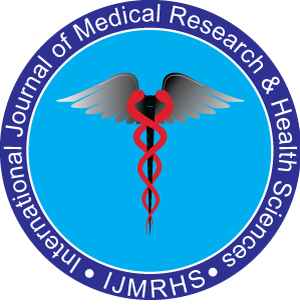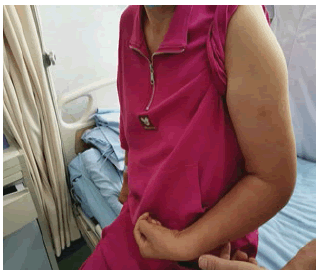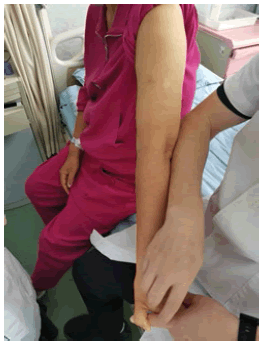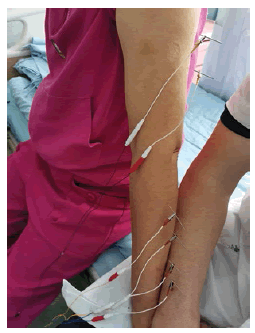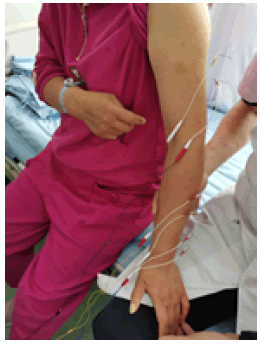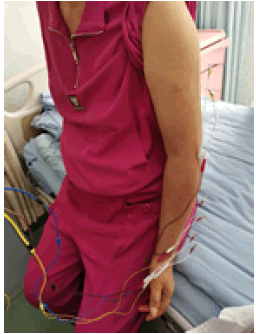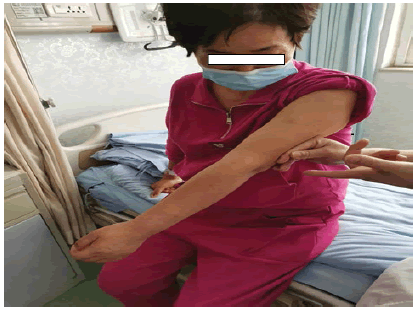Mini Review - International Journal of Medical Research & Health Sciences ( 2022) Volume 11, Issue 9
Demonstration of Functional Acupuncture and Moxibustion on Upper Limb Muscle Tension After Stroke Rehabilitation
Liu jing1, Zuo Guanchao2, Han Bingxue3, Wang Yongxia2, Cong Bei3, Zhao Lu2, Xie Li2, Sun Yu3, He Wei2, Chen Xinxing1, Ma Ten2, Chen Wei2, Shao Ming1* and Yan Zhi2,3*2Department of Integrated traditional Chinese and western medicine, Affiliated Sichuan Provincial Reh, China
3Department of Acupuncture and Tuina, Dalian Port Hospital, Dalian, China
Shao Ming, Department of Neurology, The affiliated Brain Hospital of Guangzhou Medical University, China, Email: qjqiaojie@126.com Yan Zhi, Department of Integrated traditional Chinese and western medicine, Affiliated Sichuan Provincial Reh, China,
Received: 13-Sep-2022, Manuscript No. ijmrhs-22-74481; Accepted Date: Sep 23, 2022 ; Editor assigned: 15-Sep-2022, Pre QC No. ijmrhs-22-74481 (PQ); Reviewed: 19-Sep-2022, QC No. ijmrhs-22-74481 (QC); Revised: 21-Sep-2022, Manuscript No. ijmrhs-22-74481 (R); Published: 30-Sep-2022
Abstract
Objectives: Stroke is the leading cause of adult disability worldwide, more than half of stroke patients will lead to varying degrees of upper limb dysfunction. This article mainly introduces the demonstration teaching of rapid intervention of upper limb flexion for a patient with stroke who has been ill for more than one year. Methods: The functional acupuncture method established by Professor Yan Zhi was selected as the intervention method, which had the following requirements in operation: a) Choice of body position for needle insertion. b) Selection of the needle insertion site. c) Selection of stimulation amount after injection. d) Real-time evaluation of intervention effect after injection. e) Can the resistance ability of the extensor muscle group of the upper extremity be aroused after the end of acupuncture? Results: After 20 minutes of intervention, the tension of the left upper limb flexor muscle group disappeared, the elbow flexor, wrist flexor, and finger flexor disappeared, and the elbow and wrist extension function of the left upper limb returned. Conclusions: The demonstration of this method highlights three aspects of significance: a) Functional acupuncture is still effective in patients with left upper limb flexion and spasm after stroke for more than one year. b) Demonstrated the immediate and outstanding effects of functional acupuncture and moxibustion in the intervention of stroke and upper limb flexion and spasm. c) Functional acupuncture is an effective method to instantly reproduce triceps resistance in patients with upper limb flexion spasms after stroke for more than one years.
Keywords
Stroke, Upper limb flexion, Functional acupuncture
Introduction
This editorial describes a comprehensive and synergistic combination of functional acupuncture to reduce abnormal muscle tone in strokes [1-3]. The research focused on in this article is related to stroke rehabilitation. Specifically, we focused on the immediate effect of functional acupuncture on the intervention of abnormal muscle tone and the relationship between dose reduction and synergistic response between exercise and activity outcomes and explored the combination of targeted training programs. Stroke is the second most common cause of death worldwide [4]. Stroke is the main cause of disability in adults worldwide. According to statistics, there are 70 million cases of stroke in China, and more than 2 million cases are added every year, and The overall incidence of stroke in Chinese residents is 1.4% (1386/100,000), [5]. In recent years, with the rapid development of medical conditions and treatment techniques, most brain Stroke patients received timely and effective treatment, so the mortality rate was significantly reduced.
Low, but still about 80% of patients with varying degrees of recovery, About 60% of the patients with upper and middle limb motor function impairment. The Anti-Defamation League (ADL) capacity of patients is weakened, the quality of life is reduced, and the family and society are also under great pressure [6]. However, if the hand function of stroke patients is completely lost, the overall function will be reduced by 27%, which seriously affects the patient’s ability to do daily living activities and leads to the deterioration of the patient’s quality of life [7].
Based on reviewing the literature on rehabilitation medicine at home and abroad, 2644 patients with stroke in Dalian Port Hospital from January 1st, 2016, to December 31st, 2018, were analyzed retrospectively. Among them, there were 785 cases of cerebral hemorrhage and 1859 cases of cerebral infarction, all of which met the criteria of inclusion and exclusion of serious diseases such as immune deficiency. Results: The type of cerebral hemorrhage accounted for 30% of strokes; there were 785 patients with cerebral hemorrhage, including 566 males (72.10%) and 219 females (27.90%). The ratio of males to females was 2.5%. The number of male patients with cerebral hemorrhage was significantly higher than that of females due to the influence of work stress and bad habits such as smoking and drinking. Among the cases of a cerebral hemorrhage in different age stages, people aged 50~60 and 60~70 account for a large proportion, accounting for 28.28% and 26.37%, respectively. Hypertension, diabetes, and coronary heart disease accounted for 71.85%, 17.20%, and 4.84% of the causes of cerebral hemorrhage, respectively. The incidence of a cerebral hemorrhage in men is significantly higher than that in women, of which there is a high proportion of middle-aged and elderly patients; hypertension, diabetes, and coronary heart disease are common risk factors [8].
85% of stroke patients have upper limb dysfunction at the onset of the disease, and about 30%-36% of stroke patients still have upper limb dysfunction 6 months after the onset of the disease, which seriously affects the patient’s motor function and activities of daily living [9,10]. Many research teams in China have been devoted to the research and technical promotion of acupuncture in the treatment of diseases, and more and more domestic and foreign literature has added more evidence for the effectiveness of acupuncture in the treatment of diseases [11-14].
Our application of functional acupuncture has achieved obvious results in the treatment of facial paralysis and upper eyelid ptosis [15,16]. The theoretical core of functional acupuncture is to highlight the improvement of patients’ function during acupuncture. The essence of the improvement of this function is assumed to form a strong neuromuscular effect in the antagonistic muscle, destroy the abnormal hypertonia of the active muscle group and the hypertonia of the active muscle group and reshape the normal neuromuscular coupling pattern. This balancing mechanism is the re-regulation of the brain’s higher regulatory centers. Functional acupuncture gives full play to the independence of the body’s selfregulation and balance, highlighting the advantages of targeted intervention.
Targeted function electric acupuncture is professor YanZhi created during the process of clinical practice of drug and the most effective non-surgical intervention high muscle tension method, research suggests targeted function electric acupuncture has strong nerve reflection effect, with ease and weakening the role of muscle tension, target function of electric acupuncture mechanism needs further research. Due to the upper limb rehabilitation in stroke rehabilitation process more difficult than the lower extremities, and a joint response to the influence of the upper limb is bigger, our work focused on the recent intervention after stroke upper limb muscle tension too high on the solution combination of the upper limb after stroke by electric acupuncture function abnormal muscle tone can quickly and effectively to solve.
Methods
The following is a demonstration teaching of functional acupuncture for the rapid intervention of upper limb flexion one year after stroke by Professor Yan Zhi in the hospital (Sichuan Rehabilitation Hospital, Chengdu, China )where he was the chief rehabilitation expert.
For more than a year after the stroke, the left upper limb showed a typical state of elbow flexion, wrist flexion, and finger flexion except for sleep, and the combined response was obvious. (Figure 1).
During the rapid intervention of functional acupuncture, the following five operations are required-
The affected limb is passively placed in the state of shoulder extension, elbow extension, wrist extension, and finger extension, to achieve the maximum extensor contraction and obvious tension reduction effect of the flexor muscle group when the target extensor muscle group is electrically acupuncture (Figure 2).
• Maintain the posture as shown in Figure 2, and select the targeted cluster for the intervention of upper limb muscle hypertension after stroke. For this patient, triceps brachii, superficial finger extensor, and abductor thumb muscles were selected, and two needles were inserted into the muscled abdomen of each group to form the best stimulation effect. (Figure 3).
• The needles in each group were fixed with positive and negative electrodes of the low-frequency therapeutic apparatus, and the functional acupuncture was electrically stimulated for 20-30 minutes with the amount of stimulation that could cause contraction of the extensor muscle group and the patients could tolerate, to improve the intervention effect (Figure 4).
• Electrical stimulation for the first 3 to 5 minutes still needs to develop physical a passive is put on the shoulder, elbow, wrist, the reach refers to the state, so as not to make the needle with joint flexion bending, 5 minutes after the lifting of passive force, then you can observe function electric acupuncture can quickly and effectively solve the prompt upper limb after stroke abnormal muscle tone was significantly reduced (Figure 5 and 6).
• After 20 minutes of functional acupuncture treatment, normal patients could immediately perform shoulder abduction, shoulder extension, elbow extension, and other actions, and the flexor muscle group tension of the affected limb was significantly reduced, which achieved the demonstration goal (Figure 7).
Discussion
The characteristic of the functional acupuncture method is to ignore the traditional Chinese meridians and acupoints injection and select the targeted muscles that can immediately terminate the symptoms (mainly the antagonistic muscles corresponding to hypertonia) as the target of acupuncture. The aim is to help the patient overcome anxiety before and during treatment through the rapid relief of symptoms, to achieve the effect of mind and body harmony. Acupuncture as an artificial means of external stimulation achieves good effect will make the compliance of patients have confidence in the recovery and rehabilitation, and indirectly, depending on the purpose of the patient’s own efforts to recover their disease, the application function of acupuncture methods we on the difficulty of the facial nerve paralysis, and drooping eyelids in patients receiving very good treatment effect [15,16].
Kaur et al. conducted an observational study of inpatients recovering from a stroke. The physical therapist estimated the total amount of time the patient spent in therapy and the amount of time active practice during therapy. These times were also objectively measured using video recordings. Physiotherapists systematically overestimated both very low measures: the average total treatment time was 56 minutes, of which only 31 minutes was active practice. These low amounts of time in practice are typical and persist even when there are strong indications of a dose-response relationship between practice and outcomes over the years [17-27]. We also found and paid attention to this problem. Our next solution to this problem is to use intelligent equipment to observe and control the risks caused by training intensity and training volume (such as setting the sub-limit of heart rate), and use functional acupuncture to improve patients’ cooperation and enthusiasm for rehabilitation training and accelerate the process of rehabilitation.
A large number of studies have investigated the characteristics and mechanisms of gait using various biomechanical assessment methods, including spatiotemporal, kinematic, and kinetic parameters [28,29]. Normal gait refers to the gait when a healthy adult moves in the most natural and comfortable posture, which has the following three characteristics: stable body, appropriate step length, and minimum energy consumption of [30-32]. However, gait training in stroke rehabilitation training will also cause the joint response of the upper limbs. The current assessment of upper limb tension change is given priority with various scales, and can trust evaluation method can be measured or less, we also basically adopt the method of video and photos to compare the change of before and after treatment, is working with university multidisciplinary cooperation is developing intelligent device for quantitative, basic requirements is equipment to meet accurate measurement and analysis of the tension change, It also provides intuitive graphical simulation for patients and data reports for doctors.
Quantifying practice dose as exercise repetitions is a more accurate and effective way to quantify practice dose than treatment time or active practice time.
But practicing dose and intensity increase will be the upper extremity brought on by a joint response to weaken the function of acupuncture tension change obviously, so we put forward the function again repeated limb after acupuncture, especially in the strengthening resistance training can start by sitting and require step at the same time, if the sitting position resistance after shoulders to outreach and lowered his footfall flexor side tension is still not up, you can add more tasks. After stability, stand up and start resisting shoulder abduction and shoulder extension and step down. If the flexion tension does not increase, you can add more tasks (we will write a special article on this part to share with you).
Of course, we are trying to use to speed up the recovery process of portable assistive devices will limb fixed to the shoulder, elbow, wrist, the reach refers to the state and then to do practice task, after training we observed upper limb tension was not significantly increased by training the joint response (we will discuss this part also wrote an article to share with you).
The urgent problems to be solved are-
• How to maintain and consolidate these effects.
• How to solve the problem of weakening the effect of various factors after treatment.
• How to use assistive devices to solve joint reaction problems.
• How to use multi-task training to solve the problem of joint response and shorten the course of treatment.
• How to use smart devices to control training risks.
• How to solve the economic burden of patients under the diversification of training prescriptions.
Conclusion
The demonstration of this method highlights three aspects of significance:
• Functional acupuncture is still effective in patients with left upper limb flexion and spasm after stroke for more than one year.
• Demonstrated the immediate and outstanding effects of functional acupuncture and moxibustion in the intervention of stroke and upper limb flexion and spasm.
• Functional acupuncture is an effective method to instantly reproduce triceps resistance in patients with upper limb flexion spasms after stroke for more than one year.
Declarations
Conflict of Interest
The authors declared no potential conflicts of interest with respect to the research, authorship, and/or publication of this article.
Source of Support
Nil.
Provenance
Invited not peer-reviewed.
Acknowledgment
This work was supported by the Key R & D Program of Guangdong Province, China under grant (2018B030339001);China Rehabilitation Hospital Association Research Award (No.20160001, No. 20160214); Sichuan Science and Technology Program of Sichuan Province, China:2018JY0664;Sichuan Medical Association Research Project of Sichuan Province, China: (NO.S16061); The National Key R&D Program of China (Grant No.: 2018YFC2001600).The Natural Science Foundation Guidance Project of Liaoning Province, China (Grants No. 20180550180; 20180550069;).
References
- Salhab, Ghadir, et al. " Mirror therapy combined with functional electrical stimulation for rehabilitation of stroke survivors' ankle dorsiflexion" Basic & Clinical pharmacology & toxicology. Vol. 125, No. 111, 2019, pp. 07030-74.
Google Scholar Crossref - Michaelchuk, Wade, et al. "Design and delivery of home-based telehealth pulmonary rehabilitation programs in COPD: A systematic review and meta-analysis." International journal of medical informatics, 2022, p. 104754.
Google Scholar Crossref - Dennett, A. M., et al. "Perceptions and work-readiness of Australian physiotherapists in cancer care: a national evaluation." Physiotherapy, Vol. 113, 2021, pp. 1-7.
Google Scholar Crossref - Feigin, Valery L., et al. "Stroke epidemiology: a review of population-based studies of incidence, prevalence, and case-fatality in the late 20th century." The lancet neurology, Vol. 2, No. 1, 2003, pp. 43-53.
Google Scholar Crossref - Dai-Jing, Zhang X., et al. "Incidence and risk factors of stroke in China based on CHNS 2015." Chinese Journal of Gerontology, Vol. 40, No. 24, 2020, pp. 5183-86.
- Yang, Xiao-hui, L. I. U. Bing, and Ba-si Ouyang. "Effect of acupuncture combined with rehabilitative training on neural functional recovery of stroke patients during recovery phase: a randomized controlled trial." World Journal of Acupuncture-Moxibustion, Vol. 24, No. 4, 2014, pp. 17-23.
Google Scholar Crossref - Goldstein, Larry B. "Effect of constraint-induced movement therapy on upper extremity function 3 to 9 months after stroke: the EXCITE trial." Current Atherosclerosis Reports, Vol. 9, No. 4, 2007, pp. 259-60.
Google Scholar - Song, Zhanqiang, et al. "Diagnostic Value of Susceptibility-Weighted Imaging Combined with Diffusion-Weighted Imaging in Early Intracerebral Hemorrhage." Contrast Media & Molecular Imaging, 2022.
Google Scholar Crossref - Saposnik, Gustavo, et al. "Effectiveness of virtual reality using Wii gaming technology in stroke rehabilitation: a pilot randomized clinical trial and proof of principle." Stroke, Vol. 41., No. 7, 2010, pp. 1477-84.
Google Scholar Crossref - Kwakkel, Gert, et al. "Probability of regaining dexterity in the flaccid upper limb: impact of severity of paresis and time since onset in acute stroke." Stroke, Vol. 34, No. 9, 2003, pp. 2181-86.
Google Scholar Crossref - Lu, Dominic P., Gabriel P. Lu, and Po-Ming Lu. "CLINICAL EFTECTIVENESS OF ACUPUNCTURE FOR MANDIBULAR SUBLUXATION AND DISLOCATION." Acupuncture and electro-therapeutics research, Vol. 35, pp. 3-4, 2010, pp. 187-92.
Google Scholar Crossref - Huang, Weidong, et al. "An investigation into the effectiveness of traditional Chinese acupuncture (TCA) for chronic stress in adults: a randomised controlled pilot study." Complementary therapies in clinical practice, Vol. 17, No. 1, 2011, pp. 16-21.
Google Scholar Crossref - Pfab, Florian, et al. "Acupuncture in critically iII patients improves delayed gastric emptying: a randomized controlled trial." Deutsche Zeitschrift fÃÃÃÂ???¼r Akupunktur, Vol, 54, No. 2, 2011, pp. 28-29.
Google Scholar Crossref - Sung, Ho-Joong, et al. "Proteomic analysis of differential protein expression in neuropathic pain and electroacupuncture treatment models." Proteomics, Vol. 4, No. 9, 2004, pp. 2805-13.
Google Scholar Crossref - Bingxue, Han, et al. "A Case Report of Functional Acupuncture in the Treatment of Senile Left Persistent Facial Paralysis." International Journal of Chinese Medicine, Vol. 5, No. 1, 2021, p. 1.
Google Scholar Crossref - Bingxue, Han, et al. "A Case Report of Functional Acupuncture for Treatment of Elderly Type 2 Diabetic Oculomotor Nerve Palsy." International Journal of Chinese Medicine, Vol. 4, N. 4, 2020, p. 90.
Google Scholar Crossref - West, Tanya, and Julie Bernhardt. "Physical activity in hospitalised stroke patients." Stroke research and treatment, 2012.
Google Scholar Crossref - Hayward, Kathryn S., and Sandra G. Brauer. "Dose of arm activity training during acute and subacute rehabilitation post stroke: a systematic review of the literature." Clinical rehabilitation, Vol. 29, No. 12, 2015, pp. 1234-43.
Google Scholar - Kaur, Gurpreet, Coralie English, and Susan Hillier. "How physically active are people with stroke in physiotherapy sessions aimed at improving motor function? A systematic review." Stroke research and treatment, 2012.
Google Scholar Crossref - Lang, Catherine E., et al. "Observation of amounts of movement practice provided during stroke rehabilitation." Archives of physical medicine and rehabilitation, Vol. 90, No. 10, 2009, pp. 1692-98.
Google Scholar Crossref - Tyson, Sarah F., Kate Woodward-Nutt, and Sarah Plant. "How are balance and mobility problems after stroke treated in England? An observational study of the content, dose and context of physiotherapy." Clinical rehabilitation, Vol. 32, No. 8, 2018, pp. 1145-52.
Google Scholar Crossref - Blennerhassett, Jannette, and Wayne Dite. "Additional task-related practice improves mobility and upper limb function early after stroke: a randomised controlled trial." Australian Journal of Physiotherapy, Vol. 50, No. 4, 2004, pp. 219-24.
Google Scholar Crossref - Manaf, Haidzir, et al. "Turning ability in stroke survivors: A review of literature." International Scholarly Research Notices, 2012.
Google Scholar Crossref - Kwakkel, Gert, et al. "Effects of augmented exercise therapy time after stroke: a meta-analysis." Stroke, Vol. 35, No. 11, 2004, pp. 2529-39.
Google Scholar Crossref - Lohse, Keith R., Catherine E. Lang, and Lara A. Boyd. "Is more better? Using metadata to explore doseâ??response relationships in stroke rehabilitation." Stroke, Vol. 45, No. 7, 2014, pp. 2053-58.
Google Scholar Crossref - Scrivener, Katharine, Catherine Sherrington, and Karl Schurr. "Exercise dose and mobility outcome in a comprehensive stroke unit: description and prediction from a prospective cohort study." Journal of rehabilitation medicine, Vol. 44, No. 10, 2012, pp. 824-29.
Google Scholar Crossref - Veerbeek, Janne M., et al. "Effects of augmented exercise therapy on outcome of gait and gait-related activities in the first 6 months after stroke: a meta-analysis." Stroke, Vol. 42, No. 11, 2011, pp. 3311-15.
Google Scholar Crossref - Nadeau, Sylvie, Martina Betschart, and Francois Bethoux. "Gait analysis for poststroke rehabilitation: the relevance of biomechanical analysis and the impact of gait speed." Physical Medicine and Rehabilitation Clinics, Vol. 24, No. 2, 2013, pp. 265-76.
Google Scholar Crossref - Balaban, Birol, and Fatih Tok. "Gait disturbances in patients with stroke." Pm & R the Journal of Injury Function & Rehabilitation, Vol. 6, No. 7, 2014, pp. 635-42.
Google Scholar Crossref - GÃÃÃÂ???©lat, Thierry, Armande L. Pellec, and Yvon Breniere. "Evidence for a common process in gait initiation and stepping on to a new level to reach gait velocity." Experimental brain research, Vol. 170, No. 3, 2006, pp. 336-44.
Google Scholar Crossref - Lin, Cheng-Chieh, Robert A. Creath, and Mark W. Rogers. "Variability of anticipatory postural adjustments during gait initiation in individuals with Parkinsonâ??s disease." Journal of neurologic physical therapy: JNPT, Vol. 40, No. 1, 2016, p. 40.
Google Scholar Crossref - Khanmohammadi, Roya, et al. "Characteristic muscle activity patterns during gait initiation in the healthy younger and older adults." Gait and posture, Vol. 43, 2016, pp. 148-53.
Google Scholar Crossref
